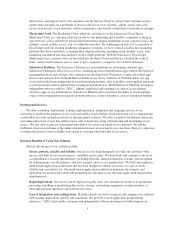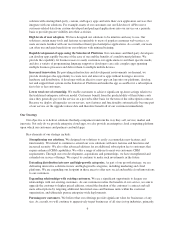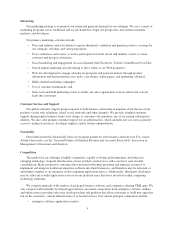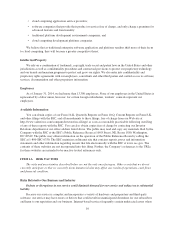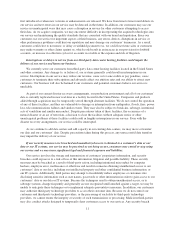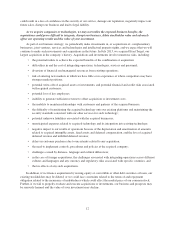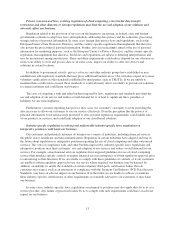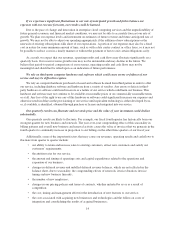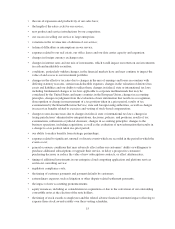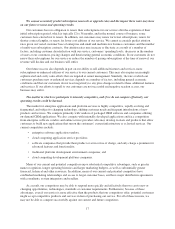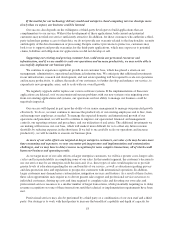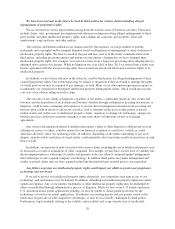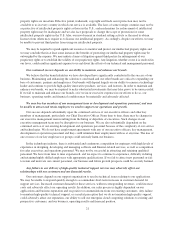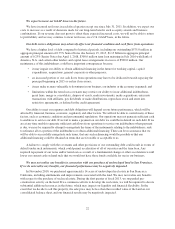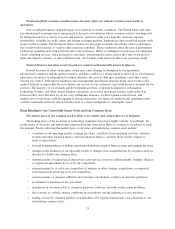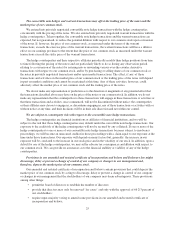Salesforce.com 2014 Annual Report Download - page 19
Download and view the complete annual report
Please find page 19 of the 2014 Salesforce.com annual report below. You can navigate through the pages in the report by either clicking on the pages listed below, or by using the keyword search tool below to find specific information within the annual report.• the rate of expansion and productivity of our sales force;
• the length of the sales cycle for our service;
• new product and service introductions by our competitors;
• our success in selling our service to large enterprises;
• variations in the revenue mix of editions of our service;
• technical difficulties or interruptions in our service;
• expenses related to our real estate, our office leases and our data center capacity and expansion;
• changes in foreign currency exchange rates;
• changes in interest rates and our mix of investments, which would impact our return on our investments
in cash and marketable securities;
• conditions, particularly sudden changes, in the financial markets have and may continue to impact the
value of and access to our investment portfolio;
• changes in the effective tax rates due to changes in the mix of earnings and losses in countries with
differing statutory tax rates, certain non-deductible expenses, changes in the valuation of deferred tax
assets and liabilities and our ability to utilize them, changes in federal, state or international tax laws
including fundamental changes to tax laws applicable to corporate multinationals that may be
considered by the United States and many countries in the European Union, changes in accounting
principles, changes in judgment from the evaluation of new information that results in a recognition,
derecognition or change in measurement of a tax position taken in a prior period, results of tax
examinations by the Internal Revenue Service, state and foreign taxing authorities, as well as changes
in excess tax benefits related to exercises and vesting of stock-based compensation;
• changes to non-income taxes due to changes in federal, state or international tax laws; changes in
taxing jurisdictions’ administrative interpretations, decisions, policies, and positions; results of tax
examinations, settlements or judicial decisions; changes in accounting principles; changes to the
business operations, including acquisitions, as well as the evaluation of new information that results in
a change to a tax position taken in a prior period;
• our ability to realize benefits from strategic partnerships;
• expenses related to significant, unusual or discrete events which are recorded in the period in which the
events occur;
• general economic conditions that may adversely affect either our customers’ ability or willingness to
purchase additional subscriptions or upgrade their service, or delay a prospective customers’
purchasing decision, or reduce the value of new subscription contracts, or affect attrition rates;
• timing of additional investments in our enterprise cloud computing application and platform services
and in our consulting service;
• regulatory compliance costs;
• the timing of customer payments and payment defaults by customers;
• extraordinary expenses such as litigation or other dispute-related settlement payments;
• the impact of new accounting pronouncements;
• equity issuances, including as consideration in acquisitions or due to the conversion of our outstanding
convertible notes at the election of the note holders;
• the timing of stock awards to employees and the related adverse financial statement impact of having to
expense those stock awards ratably over their vesting schedules;
15


